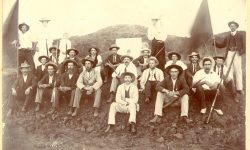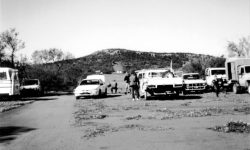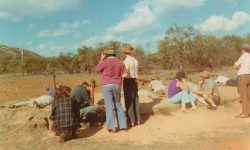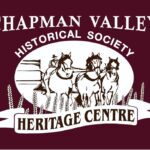The History of the Mt Erin, Nabawa and Chapman Valley Rifle Club
Rifle shooting was a popular attraction in the early days of the valley and still is today. The local detachment of 10th Light Horse Volunteers used a range on the east side of Poison Hill as did other local people.
With closer settlement of the district it was necessary to relocate the range so it was moved to its present site on the eastern side of Nabawa,the Mt. Erin hill serving as a buffer.
Friday, 19 July 1907 the Geraldton Express ran an article written “From a Correspondent”.
A very successful meeting was held at the Miners’ Arms Hotel, Nabawah, on Saturday evening last, 13th inst., in connection with the formation of a rifle club in this district. Mr. L. C. Burges, sen., was voted to the chair, and read a letter from Captain H. W. Pendlebury, supervisor of rifle clubs, which was a reply to Mr. B. J. Forrester on the subject. The letter explained the necessary preliminaries to accompany the application to form a rifle club, before submitting to the Governor-in-Council, and, in addition the chairman read at length the rules and regulations prescribed by law for rifle clubs. The meeting then proceeded to appoint a committee and officers, and the following gentlemen were unanimously elected: Mr. R. J. Forrester, captain; Mr. S. Grist, secretary; Mr. S. H. Jupp, sen., treasurer; Messrs. W. Jupp, T. Ronan, A. Gray, and L. Forrester, committee. After some discussion Mt. Erin Hill was chosen as the place in which to put a range, and the committee will visit this locality on Monday, 22nd inst., to choose a suitable spot. The new rifle club will be known as the Mt. Erin Rifle Club, and, upon selection of the site for a range, the secretary has been instructed to notify the supervisor of rifle clubs. The entrance fee was fixed at 5s, which, with the Government grant of £20, is estimated to cover all expenses. As showing the spirit of enthusiasm with which this movement is taken up, the chairman was able to announce the names of 33 gentlemen anxious to join. Mr. S. H. Jupp, sen., treasurer, generously offered a silver prize, valued at not less than £2.10s, for the best score made during a period of six months, which was accepted with grateful applause. A vote of thanks to the chairman terminated the meeting. After the close of the meeting, musical contributions were given by Messrs. L. Forrester, S. Grist, S. H.Jupp, sen., Will. Jupp, T. Ronan, and C. Burges; and a very enjoyable couple of hours succeeded one of the most successful meetings held in this district for some considerable time.
Another meeting was held at the Miner’s Arms Hotel on Saturday, 18 October 1907 to make final arrangements for the establishment of the club.
The formal opening at the new range of the Mt Erin Rifle Club took place on Saturday 13 February 1909. The celebrations, in the form of a picnic and rifle match, attracted a large gathering of settlers from Nabawah, Mount Erin and Northern Gully and a few visitors from Geraldton, including the Mayor, Mr William Jose.
The first captain was Ray Forrester and Mrs Forrester opened the range by firing the first shot at the target. She scored a bull’s eye and received a round of applause.
Unfortunately, the opening was marred by an accident of a little girl, the daughter of Mr George Penn. A dray on which a tank of water was standing, tilted up with the result that it fell on the child’s hand, severely crushing it. The little sufferer was taken to Dr Moffitt at Northampton.
There was great interest taken in the shooting, with about 35 competitors.
The results of the opening day were:
J Hipper
G. Baker
R.J Forrester
Handicap
25
38
27
Score
53
36
42
Tl
78
74
69
R. J. Forrester
Samuel. A. Grist
George Baker
Samuel Hadley Jupp
Edward Maitland Gray
James B. V. Thomson
David Alexander Gray
William Frank Jupp
Walter Osborne Jupp
Walter J. Gould
Stephen Henry Ronan
Vernon M. Barndon
John Nelson
Lockier C. Burgess
Thomas Hall
George Penn
William Ronan
William Oxenham
David E. Patten
Alexander Lauder
John Ronan
Samuel Ronan
Timothy E. Ronan
Thomas Ronan
Thomas McNaught
John Allender
Howard Wilson
Edward Neal
Charles B. Pearson
Henry L. Forrester
William L. Gray
Francis Cooper
John Cooper
G.W. Neville Forrester
Edgar M. Patten
Francis E. Ronan
James J. Meehan
Joseph M. Cooper
James W. C. Eastough
Henry Norris
William Eastough
Charles Lauder
James Hipper
Frederick Maynard
James Lauder
Samuel E. Gould
Fred Allwood
Charles Smith
William Robert Gould
Henry E. Speedy
William H. Kane
In 1910, the Durawah Rifle Club was formed which lead to Mr L Forrester resigning and becoming captain of that team. By 1911, the Mt Erin Rifle Club had sixty members.
Flooding was a problem, as reported in the Geraldton Guardian 18 Jun 1912. The club went into recess owing to water flooding the butts and resumed again in September.
In the lead up to WWI, the military and cadets occupied the range, interrupting practice. The rifle club went into recession while these trainings were being conducted. Several members received notice to hold themselves ready to proceed to headquarters when called upon.
Many men at this time joined rifle clubs to learn the fundamental skills of military drill. It was felt that if events overseas escalated and their services were required, they would have the satisfaction of knowing they had already acquired some preliminary training and were better prepared.
The club went into recess and did not resume again until 1921 when memberships returned to the level they were prior to the war. Charles Whitehurst was the secretary and the membership remained at 5/- per year.
The Rifle Clubs could not be used during wartime, therefore the club went into recession again during the Second World War and a meeting was held at the Rifle Range at Nabawa in July 1955, with the purpose of re-starting the club. At this meeting, the club changed its name from the Nabawa Rifle Club to the Chapman Valley Rifle Club. The club colours would remain that same, maroon and gold with green pin stripe edging.
The official opening day for the Chapman Valley Rifle Club was planned for Sunday 10 April 1956.
Gwen Hayley remembers she was about ten years old and lived not much more than a quarter of a mile from the firing mounds. She grew up within easy earshot of the Chapman Valley Rifle Club. I punctuated each weekend throughout the season Saturdays with the sound of rifle fire. Not that much notice was taken as like anything, you soon become indifferent to it.
Guns were, after all, part and parcel of our rural life, an absolute necessity. If an animal became sick or was badly injured, there was no other humane way to put it out of its misery. And there was no one else to do it for you. There were still no vets, even in Geraldton, in 1956, and when they did arrive, we were twenty-five miles away. The farmers were all animal lovers, but they had to be realists too!
No one touched Dad’s rifle. He had a rule about guns and it was one of those rules with no grey edges. Guns were out of bounds. They were never ever left loaded, except when actually in use. The ammunition was stored separate to the firearm and we were not allowed to touch them.
The range however was just another sporting venue. Boys still played war games with make-believe guns and without any suggestion they should do otherwise. The Second World War was still fresh in our parents’ memory and no one had yet complained that war games were inappropriate for kids.
In the early sixties schoolboy Army Cadets cycled home with their .303 slung across their back. The bolt was in the school bag. The rifle was taken home for cleaning then put back together again prior to next week’s cadets.
When the range was not in use we would climb the hill that is Mount Erin. We clambered over the timber trig point that was then still standing on its highest peak and explored the nooks and crannies on the hillside. We disturbed foxes and snakes, occasionally.
Mt. Erin was only out of bounds to us on shooting days.
The Rifle Range Reserve occupies 136 acres adjacent to Lot Nos. 5259, 5260, 1967 and 5258. The land being originally part of the Morrissey Mt Erin Estate and subsequently owned by John Ronan, Gus Nelson, Ernie Gould, Bert Fawcett and Frank Warr.
Barney Webb won the first trophy on the reopened Chapman Valley Rifle Range. It is a much treasured beer stein, won at a handicap shoot and engraved:
“A.M.Webb 1956 Chapman Valley Rifle Club L.A.Head Trophy.”
(Mr. Head was the accountant at the Protheroe mine.)
Mr. Webb said he had never had anything to do with a rifle movement and was not involved in any other sport at the time, so thought it would be a good idea to go along. Tom Allan and the others from Protheroe acted as coaches to the beginners, “We were all beginners – tyros – a tyro is a beginner”, Barney explained. From the start, Tom Allan had said that he “Looked like being quite a good shot”. “You need to be steady … a good temperament … but mostly it is about reading the conditions of the day. It’s no good being an excellent shot in good weather if you can’t read the conditions when the weather goes bad”, said Mr. Webb.
Barney went on to win the Tyro Cup, held at Swanbourne in 1959 as part of the Queen’s Prize. This competition is run by the National Rifle Association of Western Australia.
Helen Criddle wrote that the Rifle Club at Nabawa became very much a family affair. It was by the late 1970s that ladies were just starting to come into the sport. She said “It wasn’t going to be a man’s world anymore.” With the new rifles being a lot light and easier to handle the women could join in and shoot on equal terms with the men, apart from the handicap!
Helen took on another role in the club when she started stretch knit sewing classes and made herself and Norm a rifle club jumper in the colours of maroon, green and gold. Before long she had made everyone in the club a jumper.
Kaye Pethick was the first lady to shoot for Chapman Valley.
The Chapman Valley Rifle Club was very strong in the eighties. In 1981 they had thirty-one financial members making them the second largest rifle club in the State for shooting members.
During the one hundred years since the inception of the Chapman Valley Rifle Club it has had three name changes, Mt Erin Rifle Club, Nabawa Rifle Club and now the Chapman Valley Rifle Club and at least two different locations. Much has changed in the sport of rifle shooting during this time. What has remained constant is its importance as a social gathering and meeting place for its far-flung members.
Sources:
Anthea Kalazich A History of the Chapman Valley Rifle Club 1902-2001. Mt Erin Rifle Club 1902-1955.
Chapman Valley Heritage Centre
National Library of Australia (Trove)




